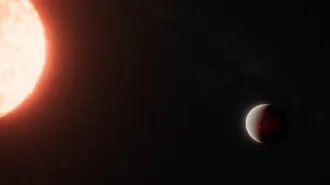It’s unclear whether it was a stellar meal or simply gas that woke the sleeping giant.
But astronomers say the ongoing outburst recorded by a spacecraft since March 28 is the first time scientists have witnessed the sudden activation of a dormant supermassive black hole.
David Burrows of Penn State University in University Park and his colleagues report their findings on the burst, which has continued for more than 30 days, in an article posted at arXiv.org on April 25. Burrows declined to be interviewed because the team has submitted its article to Nature.
When NASA’s Swift spacecraft first spotted the fireworks in a distant galaxy in late March, researchers classified the event as a gamma-ray burst, which typically lasts for only a few minutes to perhaps an hour (SN Online: 4/7/11).
Swift must have caught the event only minutes after its onset; images taken by the craft an hour earlier showed no such activity from the galaxy, which lies about 3.8 billion light-years from Earth.
Over the past decade, X-ray satellites have three times recorded X-ray and visible-light flares in distant galaxies that may have marked the activation of a black hole. But all three events were spotted days to weeks after the flares began.
As time went on and the energetic emissions associated with the March 28 outburst continued, Burrows and his collaborators say they became convinced that a quiescent black hole — similar to the sedate monster at the center of the Milky Way — was switched on by either supping on a nearby star or swallowing gas expelled by the explosion of several nearby massive stars. As the food supply spiraled into the black hole the object generated the high-speed, X-ray emitting jet, the researchers propose. Alternative theories seem less likely the longer the jet persists.
“The paper makes a very convincing case that a massive black hole was indeed activated,” comments theorist Zoltán Haiman of Columbia University. Monitoring the star for several years should reveal the origin of the fuel, he adds. If the black hole swallowed a single star, the jet will dim, but if the object suddenly gained access to a large reservoir of gas, the jet could stay bright for more than a thousand years.
Haiman and his colleagues recently proposed a scenario for how a black hole could snare a large supply of gas. If two black holes were about to merge, their motion would clear gas from their vicinity. Once the holes merged, gas would be free to rush in, he and his collaborators suggested last year in the Astronomical Journal.
If the Milky Way’s supermassive black hole were to generate a similar jet aimed at Earth, it would be 40 times stronger than the brightest known X-ray solar flare and would strongly ionize the planet’s upper atmosphere, harming life, the team notes. Fortunately, they add, the probability of such a jet beamed at Earth is extremely low.







